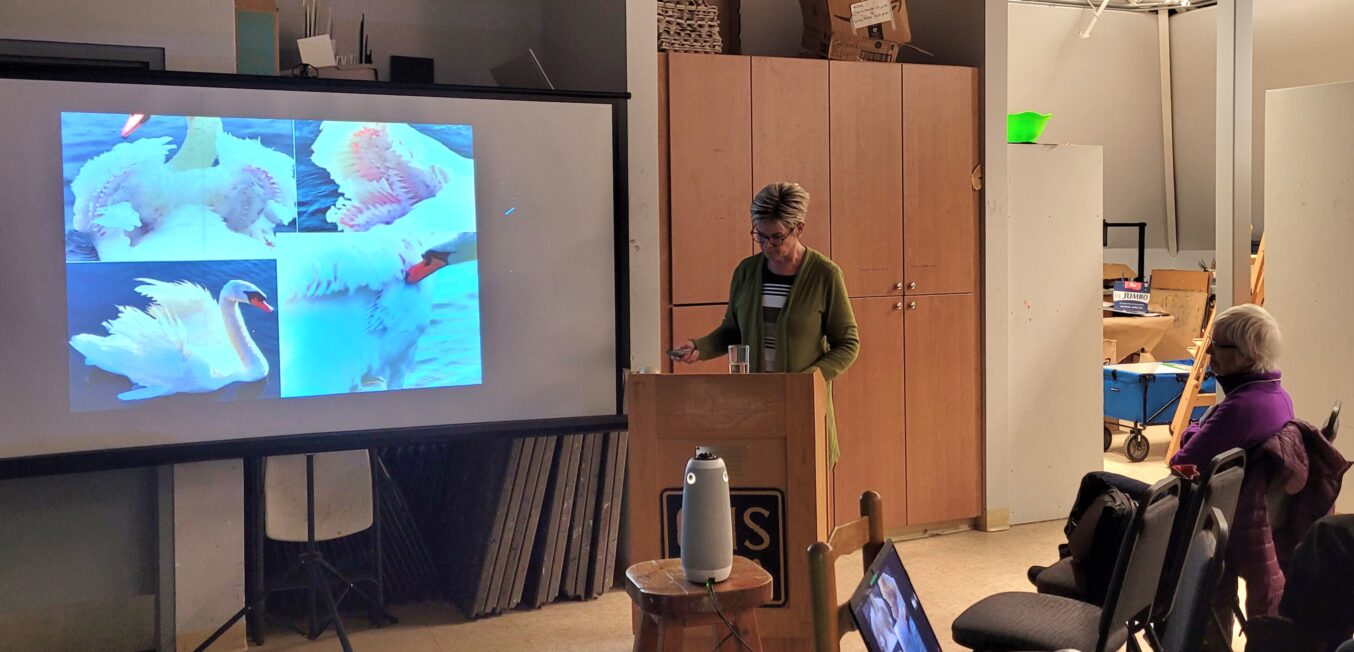Thanks to the 34 people who attended in person and 25 people on Zoom for our February meeting with Kelly Duffin from the Mute Swan Society.
Kelly’s presentation covered identification, history, population and range, life cycle, social and common behaviours and common misconceptions. The presentation focused on one pair – “Mama and Dad Swan” (being parents is a big part of their lives, and Kelly doesn’t want to humanize them too much).
Kelly is the Founder of the Mute Swan Society. Mute Swans (whose Latin species name is cygnus olor) are intelligent, majestic, orange-beaked water birds. They have been the subject of myth and art and a symbol of beauty and love for centuries. They are admired and beloved by many in Canada and around the world for their lasting pair bonds and the care both parents give to raising their young.
History & Identification:
Females are called pens and males are called cobs. The distinguishing feature is their orange beaks at maturity. Swans have been on earth for 11 million years – about twice as long as humans. Mute Swans have nested in Ontario for over 65 years, or more than 18 generations.
Birds are descended from dinosaurs. Swans are believed to have appeared in the northern hemisphere between the Miocene and Pleistocene eras (23 – 3 million years ago). Beginning in the late 1800s, Mute Swans were introduced on other continents, including North America. The first wild Mute Swan nest in Ontario was found in 1958. Their population is largely focused in the lower Great Lakes region.
On average, swans have 25,000 feathers. Cleaning and preening is a large part of their lives. They regularly stand with one leg tucked up – it is normal behaviour! Busking is a threat display to defend territory.
Mating and Nesting:
They select a mate at 2-3 years old and mate for life. Once they pair up, they need to find a territory. They build a nest in March/April, usually 6 feet wide. They need to be able to get cygnets into the water quickly. 24-48 hours required to produce an egg and the average clutch is 5 – 9 eggs. 1 brood a year in spring/summer. Typically hatch in May/June. There is a 35 day incubation period by the pen. The pen plucks out some feathers so her skin will touch the eggs and keep them warm. During incubation, she rarely leaves the nest. She will rotate the eggs periodically.
Common Misconceptions:
- They are sometimes labeled as invasive (not substantiated by evidence)
- Sometimes accused of destroying habitat (not substantiated by evidence)
- Accused of being aggressive (will defend mate, nest and offspring)
- population growth sometimes described as “explosive” (nowhere close to barrying capacity)
These characterizations are lethal. Juveniles and adults are killed on private and federal property. Destruction of their eggs and nest. Learn more here: https://muteswansociety.org/issues/common-misconceptions-about-mute-swans/
Thank you Kelly for your presentation!
Comments and Summary:

